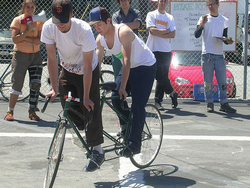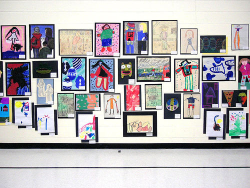Spinnennetz
Spinnennetz

Foto von Jus' fi (abgerufen am 30.09.2009)
Kurzbeschreibung
Ohne das Spinnennetz zu berühren, passieren die Teilnehmer verschiedene Öffnungen im Netz. Andere Teilnehmer helfen, denn es handelt sich um eine Gruppenübung.
Ablauf
Seile spannen.
Die Teilnehmer überwinden das Netz, indem sie durch verschiedene Felder krabbeln, steigen, hüpfen ...
Zusatzregeln:
Es darf keine Öffnung zweimal verwendet werden.
Durch das Netz darf nicht gegriffen werden.
Bei Berührung wird noch mal begonnen.
Benötigte Tools und Materialien
Offline:
Mehrere Seile oder starke Schnüre zum Knüpfen eines Spinnennetzes.
Beispiele und Links
Kommentare
Diese Übung schult die Zusammenarbeit innerhalb einer Gruppe. Im Freien müssen Bäume vorhanden sein, die dicht beieinander stehen.
Subject Sampler
Subject Sampler

Image by neofob (Access: 01.10.2009)
Short description
In a Subject Sampler learners are presented with a smaller number (maybe half a dozen) of intriguing Web sites organized around a main topic. They are asked to visit the sites and respond to information found there. The selected sites can include photographs, art, music, text, and a variety of other types of information. What makes this a particularly effective way to engage students is that the teacher has chosen Web sites themselves that offer something interesting to do, read, or see about a given topic. Teachers can use a Subject Sampler when they want students to feel connected to the topic, to get emotionally involved in the topic, and to feel that the topic really matters.
Process description
Teacher create list of Internet sites for students.
Students are asked to respond to the Web-based activities from a personal perspective (their perspectives on topics, comparisons to experiences they have had, personal interpretations of artworks or data, etc.)
Required resources
Computer, Internet
PSI: https://psi.methopedia.eu/learning-activity/subject-sampler
Tandem
Learning in tandem

Photo by unaesthetic (retrieved on 30.09.2009)
Short description
Two people are learning together a subject.
Process description
First, the participants must be divided into groups, then a time limit has to be set; for example: You have 10 minutes. What can be learned together?
One possibility: each group works with the content of a learning station.
Another possibility: each group solves the tasks of a learning station.
Required resources
Nothing special
Examples
Extreme Programming: https://en.wikipedia.org/wiki/Extreme_Programming
Comments
When two programmers sit in front of a single computer and develop a software program, we are talking about extreme programming. Four eyes see more than two. Two brains are better than one! Each can learn from the other.
Teilnehmergalerie
Teilnehmergalerie

Foto von striatic (abgerufen am 16.10.2009)
Kurzbeschreibung
Die Teilnehmer lernen sich mit Hilfe der Online-Lernplattform kennen.
Ablauf
Vor einer Kursleiterfortbildung, sei es ein Seminar, eine Folge von Einzelveranstaltungen oder eine onlinebasierte Aktion, gestaltet der Moderator eine Galerie auf einem Server oder einer Kommunikations- bzw. Lernplattform, die allen Teilnehmerinnen und Teilnehmern zugänglich ist.
Dort stellen die Moderatorinnen und Moderatoren sich persönlich vor (am besten mit Foto) und teilen in der gebotenen Kürze all das mit, was sie für wichtig halten (z. B. ihre Vorstellungen zur gemeinsamen Arbeit, Organisationshinweise usw.)
Anschließend sammelt das Moderator Daten der Teilnehmer (Name, Fotos und was sonst noch interessant sein könnte) und stellt dies in die Galerie ein. Bei entsprechenden technischen Voraussetzungen machen das die Teilnehmer selbst. Bei einer Direktphase (face-to-face) sollten Fotos und Daten ausgedruckt oder als Wandbilder vorliegen. Die Daten lassen sich später ergänzen. Neue Teilnehmer werden nach und nach in die Teilnehmergalerie aufgenommen.
Benötigte Tools und Materialien
Online:
Computer
Internetanschluss
Lernplattform
Beispiele und Links
Noch keine. Hilf mit hier ein Beispiel einzustellen. Melde dich bei Methopedia!
Kommentare
Das Verfahren erleichtert und beschleunigt die Kennenlernphase und trägt dazu bei, dass die Teilnehmer bereits im Vorfeld auf die Fortbildung und die Nutzung von Computer und Internet eingestimmt werden.
PSI: https://psi.methopedia.eu/learning-activity/usergallery
Test questions
Test questions

Image by Ben+Sam (Access: 18.04.2011)
Short description
Allow students to write test questions and model answers for specified topics, in a format consistent with course exams. This will give students the opportunity to evaluate the course topics, reflect on what they understand, and what are good test items.
Process description
Make a rough tally of the questions your students propose and the topics that they cover.
Evaluate the questions and use the goods ones as prompts for discussion.
You may also want to revise the questions and use them on the upcoming exam.
Required resources
None
Texting
Texting

Photo by Nils Geylen (retrieved on 15.10.2009)
Short description
Learn to express thoughts concisely.
Process description
Participants are asked to send a fictional text message with 11 words to a person they know (school director, school board member, spouse, child, etc.) at the end of a meeting or after a session of a conference.
The messages are then read aloud.
Required resources
Paper
Pencil
Examples
Positive atmosphere:
Sharpened perception
5 days really learning by doing
An intensive week with many experiences
Doubts disappeared
Model actually feasible
Successful week
Great methods
Feedback:
Tiring discussion
Extravagant claims
Dreamers and malcontents
Utter frustration
Comments
The restriction helps to concentrate on the most essential substance. Severe brevity of the form can generate linguistic creativity.
Triangle of commonality
Triangle of commonality

Photo by Rafael Penaloza (Access: 28.09.2009)
Short description
For this activity, participants form groups of three. They look for similarities based on previously agreed upon criteria.
Process description
Three participants form a small group, they receive a large piece of paper and three pens.
They draw a triangle. Near the corners they each write their name, age and other identifiying information.
Then they draw commonalities which they have found during the conversation next to the sides which connect two people (e.g. Joe and Jane like to go snowboarding), or in the middle of the triange in case the all have this feature in common.
After the assigned time has passed, each person is introducing someone from his/her group to the whold group.
Required resources
Wallpaper
Pens
Comments
A positive aspect of this activity is that commonalities are being visualized. Finding commonalities can strengthen group cohesion.
PSI: https://psi.methopedia.eu/learning-activity/triangle-of-commonality

Image by Roo Reynolds (Access: 15.12.2009)
Short description
A new way to engage students through social software – the possibilities of Twitter as a tool for communication and reflection.
Process description
Each participant signs up on twitter.com with a username.
Depending on the purpose of using Twitter in class the facilitator should make a hashtag # to label the course. It could be #ILS09 or #coursename.
During the course you should ask the students for a number of tweets for each lecture and tag it with the hashtag.
The result of using Twitter in educational settings is a back channel for communication and reflection among students and teachers. Here discussions can be facilitated and you can follow up on different areas of interest.
It is important that you make at clear what the purpose of using Twitter is and how many tweets you expect from each students to start the process of making twitter a part of your teaching.
Required resources
Laptops, internet connection and a Twitter account.
Examples
Currently I am co-teacher at course called ICT, learning and collaboration where four students are participating and a remark from that experience is that it is difficult to facilitate discussion. We believe that there would be more activity on twitter - re-tweets, direct messages etc. - if the student were a bit large.
It is also difficult to assess the activity in a qualitative manner because you cannot control the structure and level of reflection on Twitter. You have to require a number of tweets and that seems like the only way to evaluate the student’s activity right now.
Comments
Twitter is also a type of informal learning.
This example is developed in relation to the two EU projects COMBLE (https://www.comble-project.eu/)
Videobridge
Videobridge

Image by vectorfunk (Access: 15.12.2009)
Short description
Videobridge is about affordable, interactive group communication possibilities by high quality video links - specifically for rural and remote learners.
Process description
The VideoBridge project aims to realize permanently available cheap group communication possibilities, preferably live and in both directions with high quality video/audiostreams via the internet.
The term "videobridge" instead of "videoconferencing" signifies that there is something happening at local scale, which we are simply enhancing (or enabling) by a "bridge" (while a videoconference is primarily an event in virtual space).
Required resources
Computers
Cameras
Sound Systems
Projectors
Microphones
Mixers
Examples
Virtual Trips: http://www.uen.org/Lessonplan/preview.cgi?LPid=22080
Comments
Streaming, Sharing and Learning (SSL) – The options for and the use of Interactive Digital Video over long distances in adult education.
Grundtvig Workshop in Vienna, January 2010 - Applications welcome!
PSI: https://psi.methopedia.eu/learning-activity/video-bridge



Social Networking
Image by aqhong (Access 10/12/2009)
Short description
Social networking sites are websites where users create personal profiles and connect with each other. The idea behind the sites is to link up with your friends and see who they are friends with and their friends’ friends.
Process description
Social networking sites excel at creating and highlighting social connections. You can usually send massages to and chat with other users, and some sites allow you to create personalized webspaces. Facebook, MySpace, and LinkedIn are some of the common examples.
When used for learning, the easy communication and connectivity of such sites can be helpful in supporting and strengthening connections between both the teacher and students and between students.
One use for social networking sites is to set up collaborative problem solving. By allowing the students to discuss a problem with each other they can bounce idea off of each other and find a solution together. This use of social networking is likely already happening, with students discussing course related subjects among themselves. By participating in or directing this discussion, a teacher can influence the discussion and assist if the problems prove too difficult.
Another use is as a way to share files and news quickly. If someone has a file that the rest of the course could use, they can quickly share it with the rest. Mind the copyrights when doing this, though. This can also be used by teachers to share course material and slides. Some schools and universities are already doing this, including official Facebook and MySpace pages, Youtube channels, and official presences in online games like Second Life.
Social networking sites can also be used to allow the students to create profiles and establish their course identity with new profiles created specifically for the course, either as a part of the course, or because the students want to keep their private profile separate from their course profile.
Required resources
You will need an internet connection and the course participants will all need to be members of the same social networking site. With younger students, this is likely already the case. You will also need to be somewhat proficient in the chosen social networking site if you want to participate in the social networking yourself.
Examples
A good reason to use social networking sites in learning is that many younger students are already avid users of social networking sites, and are used to communicating like that.
Social Networking in plain English:
Comments
This example is developed in relation to the two EU projects COMBLE (https://www.comble-project.eu/).
PSI: https://psi.methopedia.eu/learning-activity/social-networking